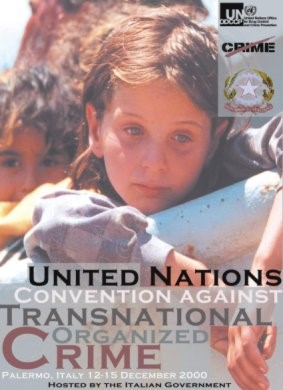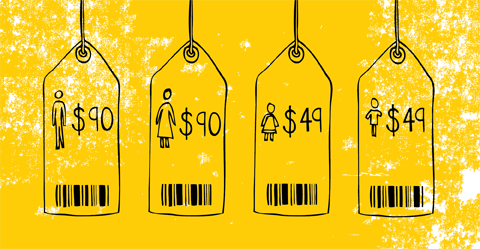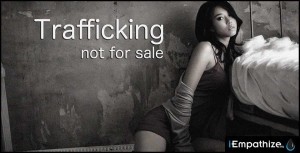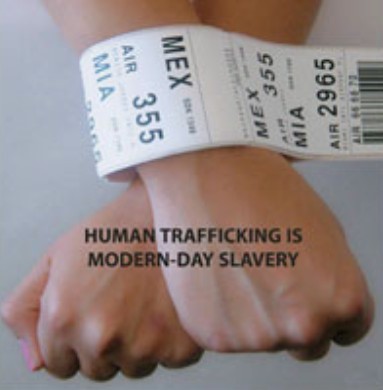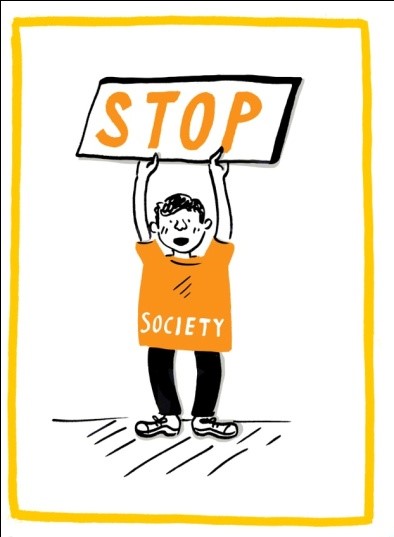INTRODUCTION
Human trafficking is modern day slavery. It is the practice of people being tricked, lured, coerced or otherwise removed from their home or country. They are then being forced to work with no or low payment or on terms which are highly exploitative. Trafficking in persons is a serious crime and a grave violation of human rights. Almost every country in the world is affected by trafficking, whether as a country of origin, transit or destination for victims. Every year, thousands of men, women and children fall into the hands of traffickers, in their own countries and abroad. The three main issues of human trafficking are: slave labour, sexual exploitation, and prostitution.
What Is Human Trafficking: Human trafficking is …… being bought & sold against your will
To be deceived or taken against your will, bought, sold and transported into slavery. For sexual exploitation, forced begging, sacrificial worship or removal of human organs, as child brides or into bonded labour. Every country is affected by human trafficking, whether it’s an origin country where people are trafficked from; a transit country where people are trafficked through; or a destination country where people are trafficked to. Often a country will be all three.
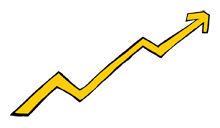 People trafficking is the fastest growing means by which people are enslaved, the fastest growing international crime, and one of the largest sources of income for organised crime. — The UN Office on Drugs and Crime People trafficking is the fastest growing means by which people are enslaved, the fastest growing international crime, and one of the largest sources of income for organised crime. — The UN Office on Drugs and Crime |
| 1.2 million children are trafficked every year — Estimate by UNICEF |
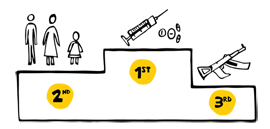 Human trafficking is the second largest source of illegal income worldwide exceeded only by drugs trafficking. — Belser 2005 Human trafficking is the second largest source of illegal income worldwide exceeded only by drugs trafficking. — Belser 2005 |
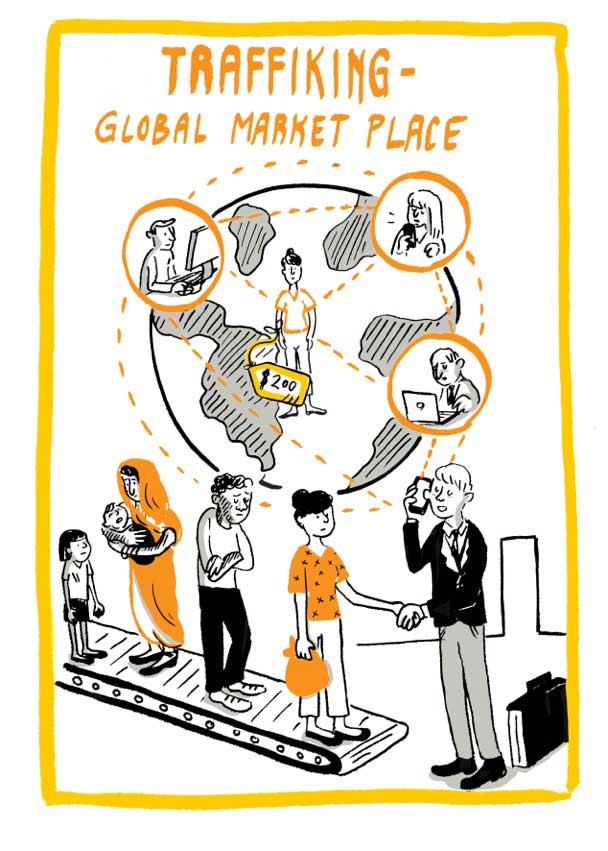 600,000-800,000 men, women and children are trafficked across international borders each year. Approximately 80 per cent are women and girls. Up to 50% are minors. — US Department of State Trafficking in Persons Report 2007 600,000-800,000 men, women and children are trafficked across international borders each year. Approximately 80 per cent are women and girls. Up to 50% are minors. — US Department of State Trafficking in Persons Report 2007 |
 At least 20.9 million people are victims of forced labour worldwide. While it is difficult to establish a precise amount, conservative 2012 research estimated trafficking victims as comprising some 44 per cent of this figure. —ILO 2012 Global Estimate of Forced Labour At least 20.9 million people are victims of forced labour worldwide. While it is difficult to establish a precise amount, conservative 2012 research estimated trafficking victims as comprising some 44 per cent of this figure. —ILO 2012 Global Estimate of Forced Labour |
 There are even reports that some trafficking groups are switching their cargo from drugs to human beings, in a search of high profits at lower risk. — The UN Office on Drugs and Crime There are even reports that some trafficking groups are switching their cargo from drugs to human beings, in a search of high profits at lower risk. — The UN Office on Drugs and Crime |
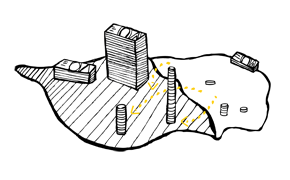 The majority of trafficked victims arguably come from the poorest countries and poorest strata of the national population. — A global alliance against forced labor, International Labor Organisation, 2005 The majority of trafficked victims arguably come from the poorest countries and poorest strata of the national population. — A global alliance against forced labor, International Labor Organisation, 2005 |
Elements Of Human Trafficking 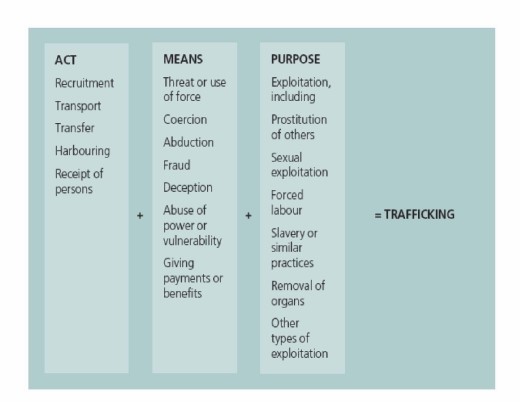 Who Is At Risk? All children and adolescents are at risk. Risk factors for being trafficked are individuals who are vulnerable emotionally or physically , such as
Who Is At Risk? All children and adolescents are at risk. Risk factors for being trafficked are individuals who are vulnerable emotionally or physically , such as
- a history of abuse or neglect,
- dating violence,
- low self-esteem,
- homelessness and poverty,
- foster care placement, and
- undocumented immigration status
- runaways
- the weak, the disabled and the oppressed
Traffickers prey upon youth who are vulnerable. They may pose as boyfriends who offer a loving, committed relationship. They may offer hope for a better life, including employment in modeling or other career opportunities. Traffickers also use other youth as recruiters to lure or help abduct girls into trafficking. They use psychological manipulation, deception, coercion, or force to isolate victims from family and friends; assume control of victims’ actions; and groom the victim to perform sexual acts with others (Chicago Alliance Against Sexual Exploitation [CAASE] Youth may also engage in sex acts as a means of surviving on the street, sometimes with the involvement of someone who arranges transactions, looks out for their safety, and possibly benefits financially (Curtis et al, 2008). What Are The Warning Signs? The following may be indications:
- shows signs of physical, emotional, sexual, or mental abuse, neglect, or malnourishment;
- has a “boyfriend” who is much older;
- has inconsistencies in his/her story, does not know his/her whereabouts or address, or appears confused;
- is accompanied by an older male or female who speaks for them (i.e., does not allow the person to speak for him/herself);
- has tattoos he/she may be hesitant to show or explain, including words that indicate ownership, such as daddy, daddy’s girl/boy, production, the name of the trafficker, or a bar code;
- displays unusual anxiety, fear, or inhibition around law enforcement;
- is resistant to seeking or receiving basic medical services;
- has not received medical care for infection or injuries.
- has recurrent sexually transmitted infections (STIs) or numerous previous pregnancies;
- talks about engaging in developmentally unusual or inappropriate sexual behaviors or practices;
- is frequently absent from school or inconsistently attends activities; and
- resides with a group of youth who are frequently escorted or transported by an unrelated adult.
How Does Sex Trafficking Influence Adolescent Health Outcomes? Reproductive health risks are especially high for trafficked youth. High numbers of unprotected sexual encounters mean that these youth are unable to prevent STIs or pregnancy, and a lack of access to services prevents them from seeking testing, treatment, or other care related to these outcomes (HHS, 2013). Trafficked youth also face an increased risk of multiple mental and physical health problems that may compound one another, including the following (HHS, 2013):
- unwanted or forced pregnancy;
- forced abortions;
- HIV/STI exposure;
- psychological abuse and trauma;
|
physical abuse;
- depression;
- post-traumatic stress reactions;
- rape and sexual assault;
- substance use and abuse;
- malnutrition;
- self-inflicted harm (e.g., cutting);
- suicide; and
|
homicide. Few Basic Tips For Adolescents To Reduce The Risk Of Trafficking, Include:
- Don’t share personal information on the Internet.
- Don’t accept Facebook requests from unknown people.
- NEVER share naked photos of yourself with anyone.
- Tell a parent or a trusted adult if you feel threatened or uncomfortable during online communication.
Adults Role In Prevention:
- Be vigilant in monitoring online activity, including your teen’s Facebook page.
- Talk with your teen about sexual trafficking.
- Pay attention to your teen’s friends and where they hang out.
You may encounter people every day and never realize they are or have been a victim. They often do not seek help immediately, due to a paralysis of not knowing who to trust and where to seek help.
References
- STOP THE TRAFFIK –What is human trafficking? stopthetraffik.org/what-is-human–trafficking
2. Teens on Trafficking www.teensontrafficking.org/
- Curtis, R., Terry, K., Dank, M., Dombrowski, K., & Khan, B. (2008). Commercial sexual exploitation of children in New York City, Volume One: The CSEC population in New York City: Size, characteristics, and needs. Washington, DC: U.S. Department of Justice. Retrieved from https://www.ncjrs.gov/pdffiles1/nij/grants/225083.pdf
- Tip sheet by ETR Associates, a subcontractor to RTI International under contract #HHSP233200951WC Task 25 with the U.S. Department of Health and Human Services, Administration on Children, Youth and Families, Family and Youth Services Bureau.
Resources
- Confronting Commercial Sexual Exploitation and Sex Trafficking of Minors in the United States (Report): www.iom.edu/sextraffickingminors
- Very Young Girls (DVD): http://www.gems-girls.org/gems-shop#very-young-girls-dvd Violence Against Women: It’s a Men’s Issue, Ted Talk by Jackson Katz: https://www.ted.com/talks/jackson_katz_violence_against_women_it_s_a_men_s_issue
Video List
|
| Last Reviewed | : | 24 Nov 2015 |
| Writer | : | Dr. Zil Failllah binti Mohd Said |
| Accreditor | : | Dr. Nazrila Hairin binti Nasir |


